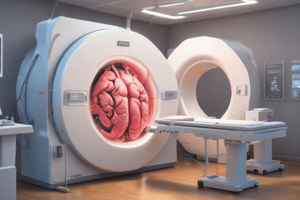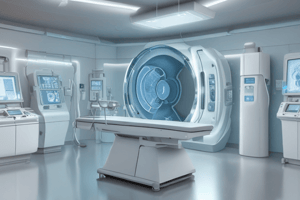Podcast
Questions and Answers
What is the primary purpose of the rotating radiation source in a CT scan?
What is the primary purpose of the rotating radiation source in a CT scan?
- To reconstruct cross-sectional slices of the patient's anatomy
- To detect the X-ray attenuation at different angles around the patient
- To transmit a highly collimated beam of X-rays through the patient (correct)
- To create a single radiographic image of the patient
What is the primary difference between a radiograph and a CT scan in terms of the X-ray attenuation data collected?
What is the primary difference between a radiograph and a CT scan in terms of the X-ray attenuation data collected?
- Radiographs do not measure X-ray attenuation, while CT scans use thousands of measurements of X-ray attenuation to reconstruct cross-sectional slices.
- Radiographs measure X-ray attenuation between the source and a single point on the detector, while CT scans measure attenuation between the source and thousands of points on the detector. (correct)
- Radiographs measure a single value of X-ray attenuation, while CT scans measure an average attenuation value for each voxel in the image.
- Radiographs measure X-ray attenuation at a single angle, while CT scans measure attenuation at thousands of angles.
What is the purpose of the computer in a CT machine?
What is the purpose of the computer in a CT machine?
- To measure the X-ray attenuation at different angles
- To rotate the X-ray source and detector around the patient
- To reconstruct the cross-sectional slices of anatomy from the thousands of X-ray attenuation measurements (correct)
- To control the movement of the patient table
What is the purpose of converting the average X-ray attenuation values for each voxel to CT numbers or Hounsfield Units (HU)?
What is the purpose of converting the average X-ray attenuation values for each voxel to CT numbers or Hounsfield Units (HU)?
What is the primary advantage of CT imaging over radiographs in terms of the information provided?
What is the primary advantage of CT imaging over radiographs in terms of the information provided?
What is the purpose of the donut-shaped tube or gantry that houses the X-ray source and detector in a CT machine?
What is the purpose of the donut-shaped tube or gantry that houses the X-ray source and detector in a CT machine?
What is the Hounsfield Unit (HU) value for air in CT imaging?
What is the Hounsfield Unit (HU) value for air in CT imaging?
Why is it important to adjust the window width and level in CT imaging?
Why is it important to adjust the window width and level in CT imaging?
What does a narrow window setting in CT imaging primarily help maximize?
What does a narrow window setting in CT imaging primarily help maximize?
Why is it necessary to use a wide window setting in CT imaging for some regions?
Why is it necessary to use a wide window setting in CT imaging for some regions?
Which tissue type would benefit most from a narrow window setting in CT imaging?
Which tissue type would benefit most from a narrow window setting in CT imaging?
Compared to radiography, what advantage does CT imaging offer in terms of contrast within the orbit?
Compared to radiography, what advantage does CT imaging offer in terms of contrast within the orbit?
Flashcards are hidden until you start studying




